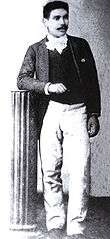Rosendo Mendizábal

Rosendo Mendizábal was the first artist of the tango. He was born on April 21, 1868, to a prosperous family in Buenos Aires, Argentina. At age three, he and his brother became orphans due to their father's untimely death.
Tangos
On October 25, 1897, Rosendo released his first piano piece, "La Casita" (elegant brothel). His first structured tango was "El Entrerriano". It was the beginning of structured tango presents three parts, unlike the primitive examples of one or two parts.
Mendizabal signed his works using the name "A. Rosendo." He usually worked as a soloist, performing at the Basque Mary, Laura, Old Eustatius Adelina the Brown, the Tarana (ex Hansen), the Milonga Street Mexico and the Center for Warehousemen.
On occasion, Mendizábal directed a quintet in the Hall Saint Martin (Rodriguez Peña 344). The other players were Ernesto Ponzio (violin), Vincent Pecci (flute), Eusebio Aspiazu (guitar), and "Cieguito" Gaudin (unknown instrument).
In addition to his best known work, "The Entrerriano" (still performed), his compositions included "Don Padilla, Pillito", "Oh, How Expensive", "That's the Thing", "In the Long Run", "The Torpedo", "Soon Return", "Entre La", "Matilda", "Queen of Sheba", "Wind in its Sails", "Tigre Hotel", " Around Here There are no Thorns", "In Light of the Lanterns", "Le Petit Parisién", "Club Z", "Don Enrique", "Alberto" and "Somos Line".
Mendizábal died on June 30, 1913. [1]
References
|